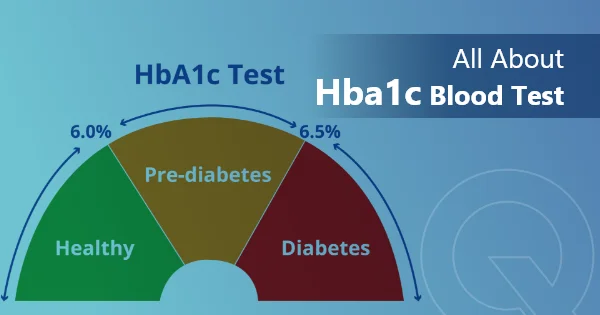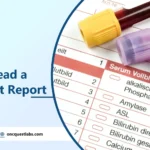Contents
Overview
Diabetes is a serious condition and a growing health concern.
More than 77 million adults in India are living with diabetes, and this number may increase to 134 million by 2045. Diabetes can lead to many complications. But there is some good news, diabetes can be managed. There are several ways to manage your condition.
Getting your HbA1c level tested, especially if you’re at risk for developing type 2 diabetes, is one such way of taking care of yourself. An early diagnosis helps you get treatment before complications can occur. HbA1c is also very useful in managing the treatment of known diabetic patients. It shows overall sugar control of the last 3 months in general.
Understanding and managing your HbA1c or A1c levels is an essential part of your overall diabetes management.
What is HbA1c?
HbA1c is known as glycated haemoglobin. When the glucose (sugar) in your body sticks to Hemoglobin present in Red Blood Cells (RBCs), HbA1c is made.
Everybody has some sugar attached to their haemoglobin. The problem arises when more of it sticks to your blood cells due to diabetes.
What is Hemoglobin?
Haemoglobin is a protein found in red blood cells and provides the blood with its red colour. Haemoglobin carries oxygen from lungs to the whole body.
What is the HbA1c test?
The HbA1C test measures the percentage of your red blood cells that have sugar-coated haemoglobin. It is a reflection of how much sugar has been circulating in the bloodstream.
It’s a three-month average because that’s typically how long a red blood cell lives.
If there’s excess blood glucose bound to the haemoglobin cells, you’ll have a high A1C. If the amount of glucose is normal, your A1C will be normal.
It is also called HbA1c, haemoglobin A1C, glycated haemoglobin, and glycosylated haemoglobin.
Blood sugar depends on several factors, such as the time of day, your activity levels, and even hormonal changes. Some people may have high blood sugar at 3 a.m. and be unaware of it.
HbA1C tests measure average blood glucose over the past two to three months, whereas finger-prick tests measure the blood glucose level in the blood at a single point in time.
Why is the HbA1C test done?
It is commonly used to diagnose prediabetes and diabetes. It is also the primary test to help you and your health care team manage your diabetes. The result of an initial HbA1C test also helps establish your baseline A1C level. The test is then repeated regularly to monitor your diabetes treatment plan. It is essential in forming your game plan to manage diabetes.
How often is the HbA1C test done?
The frequency of the HbA1C test depends on several things, like:
- The type of diabetes you have
- Your blood sugar control
- Your treatment plan
For example, the HbA1C test may be recommended:
- Once every year, if you have prediabetes.
- Twice a year, if you don’t use insulin and your blood sugar level is consistently within your target range.
- Four times a year, if you take insulin or have trouble keeping your blood sugar level within your target range
- The frequency may change if the doctor changes your diabetes treatment plan or you begin taking new diabetes medication.
Who Should Get an HbA1C Test, and When?
- If you’re over age 45
- If you’re under 45, are overweight, and have one or more risk factors for prediabetes or type 2 diabetes.
- If your result is normal, but you’re over 45, have risk factors, or have ever had gestational diabetes, repeat the HbA1C test every three years.
- If your result shows you have prediabetes, talk to your doctor about taking steps now to improve your health and lower your risk for type 2 diabetes. Repeat the HbA1C test as often as your doctor recommends, usually every 1 to 2 years.
- If you don’t have symptoms, but your result shows prediabetes or diabetes, get a second test on a different day to confirm the result.
- If your test shows you have diabetes, ask your doctor to refer you to diabetes self-management education and support services so you can have the best start in managing your diabetes.
- If you show symptoms such as:
- Frequent urination
- Excessive thirst
- Weight loss
- Increased Hunger
- Extreme fatigue
- Blurry vision
- Slow-healing wounds
- Tingling or numbness in the feet or toes
Understanding HbA1c test results
HbA1c readings are reported as a percentage and are interpreted as below:
A1c Level Indication
Less than 5.7% Normal
5.7% to 6.4% Prediabetes
6.5% Diabetes
How to lower HbA1c?
Diabetes management takes work. But the time and effort can result in reasonable control and improved quality of life. The key to reaching your A1C goal is to follow a healthy lifestyle. The following can help:
- Get your body moving.
- Eat a balanced diet with proper portion sizes
- Follow the diabetes treatment plan
- Check your blood sugar levels as directed by your doctor
Improving HbA1c by as low as even 1% for people with type 1 diabetes or type 2 diabetes cuts the risk of microvascular complications such as Retinopathy, Neuropathy, and Diabetic nephropathy (kidney disease)
They are less likely to:
- suffer cataracts
- suffer heart failure
- suffer amputation or death due to peripheral vascular disease
- have myocardial infarction
How is the HbA1c test done?
The HbA1c test is a simple blood test with no need for fasting before the test. The blood sample can be taken by the doctor or at a pathology lab.





